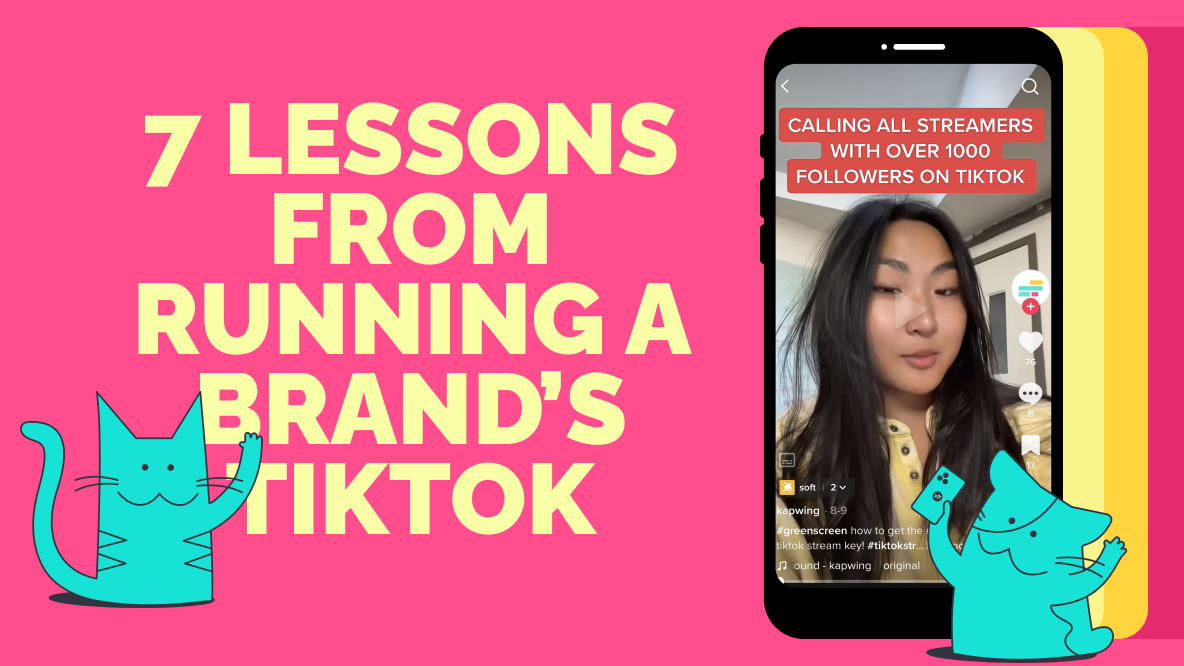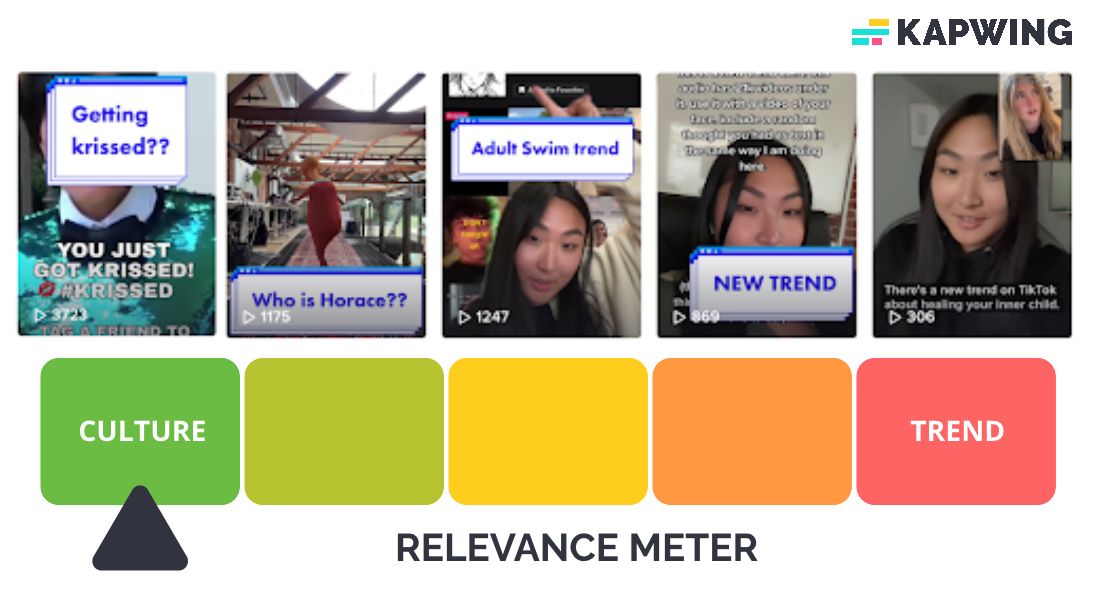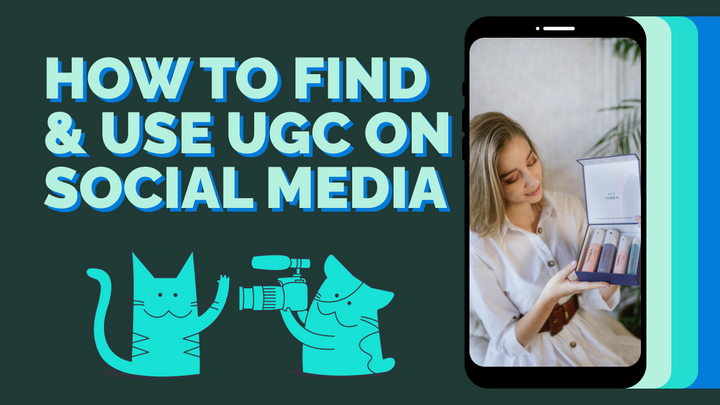7 Lessons from Running Our Brand's TikTok Account
What's it like behind the scenes of a brand on TikTok? This article is the account of my experience running a TikTok account for a brand, and the lessons that I’ve learned along the way.

Being a brand on TikTok is hard.
For context, I am the content creator behind Kapwing’s TikTok. Kapwing is a web-based video editing platform made to help you repurpose your content for social media. At the time I am writing this, our TikTok account, @kapwing, has 26.4k followers and 471.7k likes.
TikTok has become a social media platform notorious for prioritizing authenticity and spontaneity over heavily-edited, high quality content, and viewers have become hyper-aware of anyone trying to sell them anything. This means that if you're a brand on TikTok, you're already at a disadvantage. However, TikTok also has its superpowers.
It is not about how many followers you have or how much money you can put into ads. At the end of the day, genuine, well-made, and meaningful content will win. It can help you increase your brand awareness, provide social proof, and build a community of loyal supporters.
In this post, I'm going to share with you seven lessons that I learned running the TikTok account for a startup.
Lesson #1: Learn from the Big Brands; Don't Copy the Big Brands
While your TikTok strategy playbook for a small brand's TikTok account will by necessity be different than that of a large brand, it's still a good idea to study larger, successful brands on TikTok. You'll just need to adapt their strategies for your brand's needs and abilities.
Let's look at two extremely popular brands on TikTok.
Duolingo (@duolingo), a language learning app, has become the blueprint for how to run an unhinged brand on TikTok. They've amassed nearly 5 million followers and 94 million likes as of August 2022 and are a talking point in every discussion about TikTok strategy for brands.
Speaking of which, Duolingo's strategy mainly hinges on Duo the Owl, their brand mascot, who makes jokes, jumps on trends, and is, in general, especially relatable to Gen-Z viewers.
@duolingo my brain these past 48 hours #Duolingo #corn #DulaPeep #itscorn #cornsong #itsgotthejuice #trend #comedy ♬ It's Corn - Tariq & The Gregory Brothers & Recess Therapy
They're also extremely active in the comments of others’ trending videos, as Duo.
Surprisingly, they rarely explicitly promote their own product. Instead, they focus on building their mascot as a cultural icon and creating a strong community that is native to TikTok and willingly interacts with their content.
Creating a mascot personality isn’t the only way brands have found massive success on TikTok. The Washington Post (@washingtonpost) is another popular account, with over 1.4 million followers and 64 million likes. While they don’t have a plushy animal mascot like Duo, Dave Jorgenson, a senior video reporter, has become a recognizable face for their brand on TikTok.
Rather than posting TikToks that directly promote their newspaper, The Washington Post decided to expand their news services by bringing them to TikTok. Most of their videos are byte-sized pieces of news, delivered by Jorgenson or somebody else on their team in a comedic way that is easily digestable to a younger audience.
@washingtonpost This meme blew up again in August, three years after it first appeared in Latin America. 🗣👤
♬ original sound - We are a newspaper.
They use a mix of trending sounds and original voices. Their video views often depend on the news they are delivering, the creativity in how they deliver it, and the relevance it has to their TikTok audience (as well as the controversy it could provoke in the comments).
While it seems that both of these brands are trying to manufacture viral content (and succeeding), that shouldn't be your main takeaway here. Instead, look at the reproducible steps to their strategies:
- Personalize your brand (whether with a mascot or a human face).
- Interact with the community.
- Offer value first, with no strings attached.
Could some of these tools lead to a viral video? Maybe, but that shouldn't be your goal. Which brings me to my next lesson.
Lesson #2: Don't Make Going Viral Your Top Priority
It is easy to see these successful brands on TikTok, like Duolingo or the Washington Post, and want to set a goal of 1 million views per video. When I first began running the Kapwing TikTok, I, too, was prioritizing the number of views per video to measure success.
While views are an important metric, it's not in the best interest of your brand long-term to only prioritize creating that one viral video. Instead, make your videos specifically for your target customer, not the general public. Take for example this stitch:
@kapwing #stitch with @milfblondie in fact, we belong within it. #taylorswift #midnightsalbum #taylorswiftmidnights #kapwing ♬ original sound - Kapwing
It didn't pop off, but it's a great example of targeting the kinds of viewers who are likely to become Kapwing users.
It can be tempting to aim for fame, but 1,000 viewers with purchasing potential are much more valuable than 1M random viewers who will never follow up with you again. What's more, based on how TikTok’s algorithm works, once you break into that coveted viral space, it's difficult to shift back to your target audience. The algorithm won’t be as helpful at targeting your right customers and your efforts on TikTok will be wasted.
Lesson #3: Create a Personality
As a brand, your focus should be to play the long game. You want to build a persona, a consistent brand personality that viewers can resonate with and expect. Whether this persona is educational and professional or purely entertaining is up to your strengths as a creator and the nature of your business.
At Kapwing, a Software as a Service (SaaS) startup focused on the creator industry, we’ve tested out many styles of content including tutorials, office humor, and educational topics. The one thing that remains constant, though, is that the person behind the camera is a creator, just like our target audience.
Sharing tools and tips that will help other creators, because I understand the struggles that creators face as a creator myself, adds authenticity to Kapwing's content. And TikTok is all about authenticity.
This TikTok has nothing to do with using Kapwing, but it serves the community which is why it got a lot of engagement:
@kapwing TIKTOK RELEASED A WATCH HISTORY FEATURE!! Long gone are the days of failing to find a video that you want to show your friend😌 #kapwing #watchhistory ♬ Roxanne - Instrumental - Califa Azul
Creators are at the heart of everything we do as a company, so it makes sense that being a creator (and everything that comes with that) is also the focus of our TikTok.
Lesson #4: Do NOT Sell Your Product
First of all, TikTok isn't going to be a huge acquisition channel for most brands. And that's ok! But it does mean that you have to start treating it like an awareness channel, not a revenue channel. So, no hard sells.
In fact, being too pushy with marketing your product can actually be detrimental to your account's success. TikTok viewers are incredibly savvy and know when they're being sold to. They know how to sniff out when something is being sold to them directly by the business that is profiting from it.
The majority of your videos should not focus on selling your product at all. Rather than only talking about the solution that you’re trying to sell, focus on introducing the problem that it solves, like in this post:
@kapwing hiddent text no more🫡 #kapwing #videoedit #studioediting #adobepremiere #finalcutpro ♬ Fame - Irene Cara
Related Articles: How Much Does TikTok Pay Creators?
Lesson #5: People Trust People over Brands
People trust other people more than they trust brands. Just look at the phenomena of influencer marketing and user-generated content. Those tactics have been so successful because the reviews and product recommendations, while paid for by brands, still come from "normal people."
As a brand account, how do you get around that? Tell stories from a personal perspective. You can go as broad as how you started your company to as narrow as something that happened at work today.
@kapwing welcome to startup tok #kapwing ♬ Somewhere Only We Know - 𓆩♡𓆪
Regardless of the topic, stories are not only unique, engaging forms of content, but they also allow your brand to connect better with your viewers. That connection will help viewers feel more invested in your success. They'll also feel more comfortable buying something in support of a person, as opposed to supporting a general business entity.
Lesson #6: Maintain cultural relevance
Maintaining cultural relevance is not about just doing every up and coming TikTok trend. Instead of just blindly using a popular TikTok sound hoping it will get you views, think about how to relate your video to a current hot topic. Don’t be afraid to talk about current events, celebrity drama, the release of a new movie or album, or even controversies.

My rule of thumb for deciding if something is culturally relevant is whether or not I could see my friends referencing that topic in real life.
Most people don’t care about your brand, especially if they just discovered you on their For You Page. Leverage their existing interest in something else instead, such as a celebrity or a TV show, to capture their attention. Then relate that back to the values or products of your brand. Viewers will be much more open to listening what you have to say and quicker to engage with the post. Culturally relevant topics do especially well for generating shares.
For example, instead of just using the trending sound and partaking in the Getting Krissed trend, I made a video explaining the trend (and then ended the video by Krissing the viewers anyway):
@kapwing Explaining #gettingkrissed #kapwing #trending #explained ♬ original sound - Kapwing
The most popular TikToks I’ve made for Kapwing have all referred to a more relevant topic, such as the Kardashians, the new season of Stranger Things, or a viral meme.
Lesson #7: Be Flexible
When you’re just beginning to build your brand, it really is all about experimenting with different formats. Consistency is important, but only after you’ve found some formats that you can replicate consistently and that will resonate well with your audience.
TikTok operates very differently for brands then social media platforms have in the past. It's all about being flexible, creating timely relevant content, and resonating with the audience on the platform. Don’t be overwhelmed by all the strategic advice you find online, the most important thing is that you are posting, looking at your analytics, and refining your strategy as you go.
For more creator resources, tips, and tricks we've picked up from running a brand created by creators, for creators, visit our Resource Library. We post new content every week. Check us out on TikTok, too! I'd love to see you there.
Create content faster with Kapwing's online video editor →








